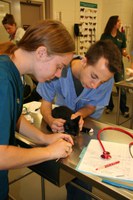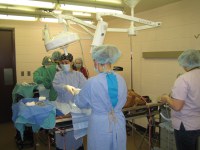Unwanted Pets Give Students Hands-on Training
(Click an image below to view a high-resolution image that can be downloaded)
Abandoned pets are helping North Dakota State University students learn.
NDSU’s Veterinary Technology program is partnering with two Fargo-Moorhead area animal rescue organizations: 4 Luv of Dog Rescue and the Cat’s Cradle Shelter Inc. management team, which runs the Minn-Kota PAAWS cat shelter. These organizations select cats and dogs that have ended up at local pounds and can pass several socialization and adoptability tests, then bring the animals to NDSU for a medical checkup and to be housed.
Students in the Vet Tech program’s clinical practicum classes examine the animals, provide general health and wellness treatments and test for health issues such as heart worm and feline leukemia. The students (56 sophomores and juniors this semester) also vaccinate the animals and assist the program’s veterinarians with spaying, neutering and implanting a microchip that can help reunite lost or stolen animals with their owners.
The students learn to work together, which prepares them for the team aspect of veterinary medicine, says Teresa Sonsthagen, veterinary technologist and lecturer in the Vet Tech program.
The students also socialize the animals. That includes helping the animals learn to get along with other cats or dogs and become housebroken. The students provide photos and details about the animals, such as personality traits, that the rescue organizations can post on their website for potential adopters.
“We see the animals under different circumstances than a foster family,” Sonsthagen says. “We can tell very quickly if they are food aggressive or they can work well with others.”
The socialization responsibility educates the students while helping them understand they are working with loving animals, not just a practice dummy, says Stacey Ostby, another veterinary technologist and lecturer in the Vet Tech program.
As part of the socialization process, the animals are housed in rooms that provide them with somewhat of a home environment, such as beds, toys, activities and opportunities to go outside.
“What we do with them helps lead them to adoption,” Ostby says.
Animals new to the program stay in separate cages away from the other animals until the students and staff veterinarians can make sure they don’t have communicable diseases.
Cats can stay at NDSU a month before going back to the rescue organizations; dogs can stay up to one semester. The organizations pay NDSU for the veterinary services and handle the adoptions.
“We’re excited to be able to offer cats for adoption who have received health checks and vet services from NDSU,” says Jill Lamp, a Cat’s Cradle Shelter volunteer. “This high-quality care provides prospective ‘parents’ with tangible proof of their cat’s health and our commitment to quality care for our residents.”
Lamp says the Vet Tech program’s students, faculty and veterinarians also help by diagnosing problems in cats at the shelter and providing medications and instructions for treating those cats. In addition, the students and faculty provide information and advice on making the shelter’s biosafety even better.
The rescue animals replace beagles that Vet Tech program students and staff raised. Working with the beagles was good hands-on experience for the students, but the dogs were used to people and didn’t mind when the students worked on them, Ostby says. Now the students are learning to deal with wiggly cats and dogs of all sizes and temperaments.
“I loved the beagles, I even adopted one, but they were all so passive and used to the process that we only got our technical skills honed,” junior Desiree Johnson says. “It’s fun to work with an animal that is realistic to a clinic setting, where they don’t know what is going to happen.”
Johnson also likes the idea of working with the animal rescue organizations.
“It gives those rescues more space to save more lives, and we have the experience of working with all size animals, from miniature pinchers to American Staffordshires, kittens to full-grown cats,” she says. “It also gives us a chance to see animals that are actually sick since a lot of the animals come from the pound. These animals have real diseases, and we need to treat and be aware of them.”
The Vet Tech program began working with 4 Luv of Dog Rescue last year. It finalized its partnership with the Cat’s Cradle Shelter management team this fall.
“Working with the NDSU Vet Tech program has been a mutually beneficial arrangement,” says Lori Green, 4 Luv of Dog Rescue secretary and grants coordinator. “It provides us with the opportunity to help more dogs, knowing we can temporarily board them while trying to find an appropriate foster or adoptive home, and it also provides the students with the opportunity to work hands-on with these wonderful dogs who deserve a second chance.”
Visit http://www.ndsu.edu/vettech/ for more information about the Vet Tech program.
NDSU Agriculture Communication - Sept. 21, 2011
| Source: | Stacey Ostby, (701) 231-7742, stacey.ostby@nsu.edu |
|---|---|
| Source: | Teresa Sonsthagen, (701) 231-7531, teresa.sonsthagen@ndsu.edu |
| Editor: | Ellen Crawford, (701) 231-5391, ellen.crawford@ndsu.edu |



